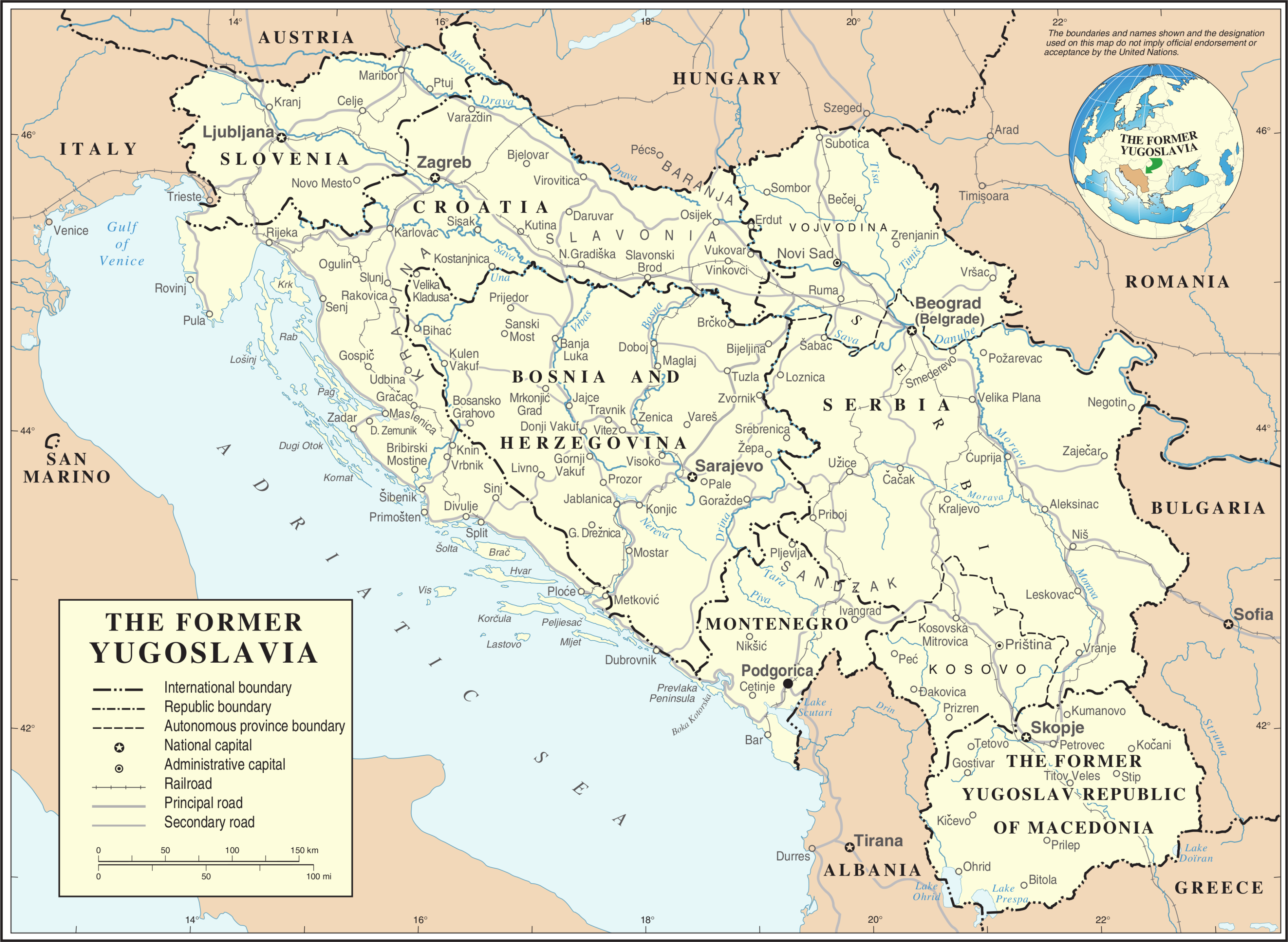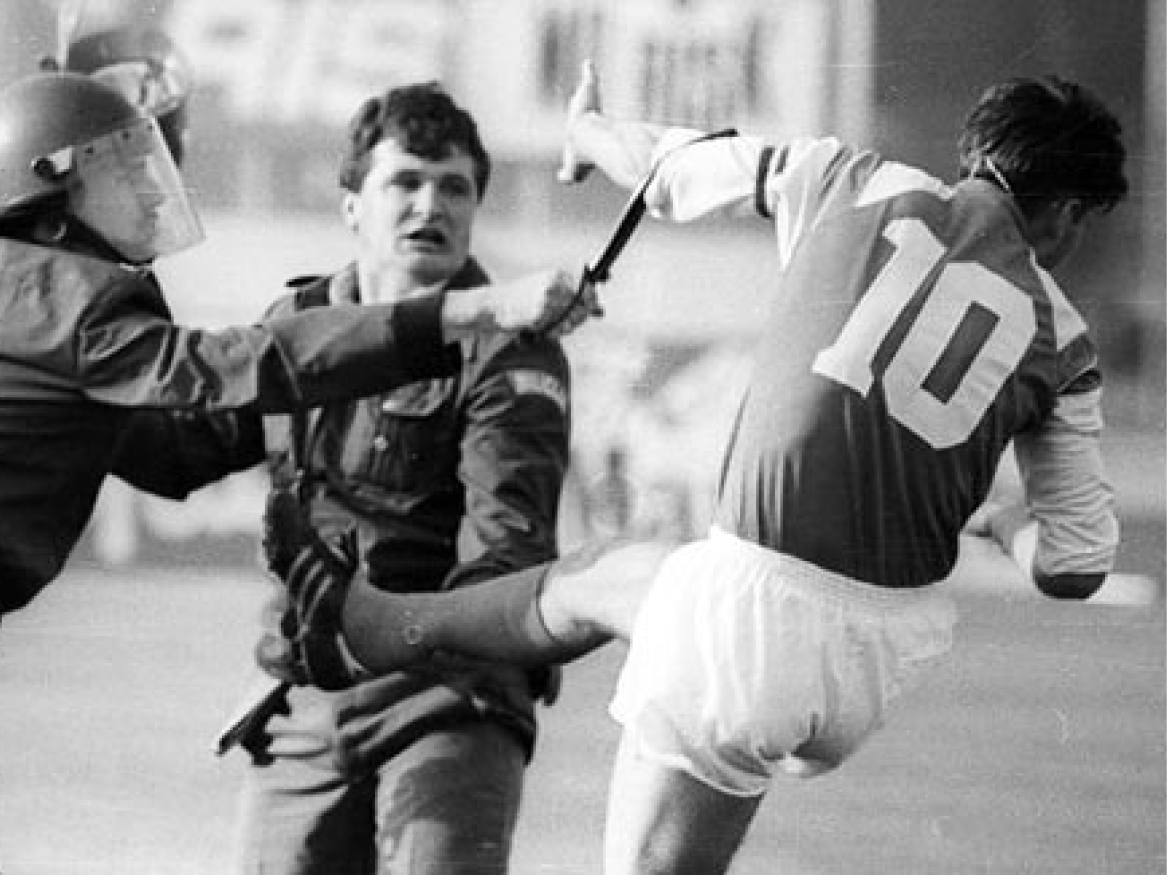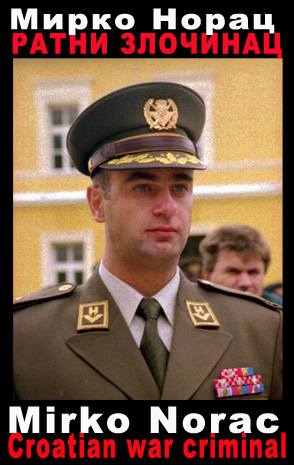|
|
Period:
Yugoslav Wars
Region:
Lika
The Croatian crime Medak Pocket - Lika 1993
The criminal operation Medak pocket or "Bloody September in Lika" was the third attack of Croatian military and police forces on the territory of the Republic of Srpska Krajina (RSK) at the time when the RSK area was under protection of UNPROFOR.
This genocidal operation started on September 9, 1993 with a sudden attack of the Croatian Army on Serbian villages in the area of "Medak Pocket" near small town Gospić, which were for 18 months under the UN protection. Within 7 days, Serbian villages of Medak pocket: Počitelj, Čitluk and Divoselo were looted and razed.
This crime was followed by the larger participation of UNPROFOR forces than it had been theretofore conflicts in the former Yugoslavia. It included the largest participation of the Canadian Forces in military conflicts since the Korean War (1950-1953).
The only person who was liable for the crimes in Medak pocket was Croatian general Mirko Norac, while general Rahim Ademi was acquitted. General Norac was sentenced to 7 years of prison for failing to prevent the crime, but since he had privileged conditions in the prison, the decision turned out to be a mockery of justice and victims.
BACKGROUND
SFR Yugoslavia was a federal state made up of 6 republics (FR Slovenia, FR Croatia, SR Bosnia, and Herzegovina, SR Montenegro, SR Serbia, and SR Macedonia). Both Yugoslavia and the JNA were established on the principle of “brotherhood and unity” of all peoples and nationalities who lived in the SFRY.
The social and economic system of the SFRY was socialism.
The 1974 Constitution of Yugoslavia brought about the decentralization of the SFRY, which later enabled the separatist forces in Slovenia and Croatia, and later in Bosnia and Herzegovina to begin the dissolution of Yugoslavia, followed by bloody wars and persecution.

In all the constitutions of Yugoslavia, the Yugoslav People's Army was defined as the only legitimate armed force in the territory of the SFRY, and therefore, the only internationally recognized military entity. At the end of 1989, the SFRY Assembly passed amendments to the Constitution, thus replacing the one-party system with the multiparty system, which meant that besides the Alliance of Communists of Yugoslavia, other parties could now be formed.
At the end of January 1990, the Alliance of Communists of Yugoslavia collapsed, at the 14th SKY Congress in Belgrade, when sharp verbal clashes between Slovenian and Serbian delegates occurred regarding the future of the joint state of the SFRY.

Opposing sides - Kučan and Milosević
The Slovenian delegation left the session, immediately followed by the delegation of the FR Croatia, which brought the issue of the congress into question. After them, the delegations of the FR of Bosnia and Herzegovina and the FR of Macedonia also left the congress.
Thus, after 45 years, the rule of the communists in SFRY ended.
The situation in FR Croatia
On the multi-party elections held in FR Croatia on 22 April 1990, the HDZ party won with its political program clearly stating the desire for independence and separation of FR Croatia from SFRY.

Collaborators against the Serbs: Tudjman and Račan
The victory sparked great euphoria throughout the Federal Republic of Croatia and displays of images of Ustasha criminals (Ante Pavelić, Alojzije Stepinac, Vjekoslav Luburić, and others), while Ustasha greetings and Ustasha songs could be frequently heard. This brought back memories of Serbs in SR Croatia of persecution and genocide in the Independent State of Croatia (The Nazi project between 1941-1945).
As early as spring, the HDZ and Franjo Tudjman took control of the police, the media, the prosecution and the state administration. Serbs working in the police were forced to leave in the spring of 1990 immediately after taking over the power, when the conflict at Maksimir (Zagreb's football stadium) between fans of NK Dinamo (Croatia) and FC Red Star (Serbia), were misused for anti-Serb propaganda.
Thus began a media war against everything that had to do with Serbia and Yugoslavia. In summer, the authorities of the FR Croatia in Zagreb made the decision to form the armed forces themselves. In October and November 1990, a large amount of weapons were illegally imported into the Federal Republic of Croatia for the needs of the reserve police forces, members of the HDZ and the VOC. The action was led by Martin Špegelj and Josip Boljkovac, ministers in the then government of Croatia.
Illegal arming of Croats
The JNA Counterintelligence Service made a film about this endeavor at the JNA military training polygon in Gakov in October 1990 and released it on TV Belgrade on 27 January 1991. On 22 December 1990, a "Christmas Constitution" was solemnly proclaimed in the Parliament, by which the Serbs lost their decades-old constitution rights and Croatia removed the name "socialist" in its name.
Since May 1990, the situation in FR Croatia started worsening day by day and the Serbs were terribly scared for their personal security and their property. Ustasha graffiti, slogans, posters could be seen regularly, and a large number of Serbs received threats by phone that they had to move out of their homes and go to SR Serbia. They even received threatening letters bearing the "HDZ" signature.

Violence in Zagreb at the Maksimir stadium
Even Croats who were married to Serbs received such threats.
Serbs in Croatia were fired from their jobs, and even their children were mentally and physically abused in schools. In almost all settlements where Croats had an absolute or relative majority, there were certain members of the HDZ party who had a task to keep an eye on the movement of their Serb neighbors (espionage).
The situation in Gospić
Gospic is a small town in the mountain region of Lika, 200 km south from Zagreb city and 180 km northwest from Split city. Serbs have had majority in this region for four hundred years. Scientist Nikola Tesla was born in the village of Smiljan in July 10, 1856, when this area was part of the Austrohungarian monarchy.
In the Second World War, Croatian fascistic authorities led by Ante Pavelić and Aloysius Stepinac committed genocide against Serbs, Jews, and Gypsies. They made a concentration camp: Jadovno-Gospić-Pag and killed more than 40,000 civilians and orthodox priests in 1941.
After WW2 many members of army and police forces of the Independent State of Croatia fled to West Europe, USA, Canada, Argentina, Paragvaj, Brasil, and Australia. They had assistance of Catholic Church. But, in homeland many Croatians and Muslims put their efforts to hide own history and war crimes.
In early 1970s, Croatian chauvinist movement MASPOK apperad, known as Croatian spring, but the Communist authorities supressed it and punished organizators in 1972.
In late 1980s, many Croatians supported militant party - Croatian Democratic Union (HDZ), and its leader Franjo Tudjman.
AGRESSION AND WAR CRIMES
The Croatian army launched offensive at around 6 am on September 9, 1993. The attack involved about 2,500 soldiers of the Operational Zone "Gospić", including the Ninth Guard Brigade of the Croatian Army, the 111th Brigade from Rijeka, the Gospić Home Guard Brigade, the Home Guard Brigade from Lovinca and special police units of the Croatian Ministry of Interior. Croatian military forces mainly possessed weapons taken from the Yugoslav Federal Army (in 1991), including M-84 tanks and a number of artillery pieces.

The Srpska Krajina Army was surprised by this attack. After two days of fighting, Croatian forces had taken control of the villages of Divoselo, Citluk, and part of Počitelj. The new front line was set near the village of Medak. The total area of the occupied territory included about 22 square kilometers, with a population of 1,300 inhabitants. In retaliation for the attack, Serbian forces began to use long-range artillery in bombing of the city of Karlovac and FROG-7 rockets in bombing of Zagreb.
Serbian forces launched a counteroffensive and regained part of the occupied territories which stopped progress of the Croatian Army. Both sides used heavy artillery during September 12 and 13, 1993 and the UN forces had notified on 6,000 explosions in the area of Gospić, and Medak Pocket. On September 12, 1993 Serbian forces fired rocket "ground-ground" on Pleso airport. Then, on September 13 and 14, 1993 Croatia used planes MIG-21 in artillery attacks on Serbian forces in Banija and Kordun, with one being shot down near Vrginmost. Pilot Miroslav Peris died while he was downing the plane on September 14, 1993.
On September 15, 1993 a ceasefire was signed by general of the Army of Serbian Krajina, Mile Novaković on behalf of Serbian side and major-general Petar Stipetić on behalf of Croatian side. Control agreement "Medak Pocket" implied the withdrawal of Croatian troops at the initial position on September 9, 1993 and that Serbian forces wouldn’t enter the territory of Medak Pocket. The withdrawal was scheduled for September, 15 at 12:00pm.

In order to monitor the withdrawal, UNPROFOR sent 875 soldiers of the Second Battalion of the Regiment "Princess Patricia" of Canadian Light Infantry to enter Medak Pocket together with mechanized unit of the French Army. UN forces under command of James Calvin were positioned between Serbian and Croatian forces. The Canadian Army within UNPROFOR was one of the best armed and prepared, but after every major incident, peacekeepers were escaping from the scene of the conflict more often than they resisted. This created doubt among the warring forces that the UNPROFOR forces were unable to do anything for the sake of peacekeeping. Under the agreement, Canadian forces were to enter the interspace of the current front and to stop Serbian forces from further advance, and take over the territory from Croatian forces.
However, the moment they entered the no man's land and tried to go through the territory occupied by Croatian forces, they faced fire opened on them by Croatian side. Canadian soldiers raised the flag of UN on their GDPs and repeatedly tried during September 16 to enter Medak Pocket. With an every such try, fire from Croatian side was becoming more intensive. Eventually, Canadians began returning fire, and it was noticed that Croatian forces had used guns of 20 mm.
Tension continued through the night and the early pre-dawn fire from Croatian side stopped, and Canadian troops began taking over the territory. They were moving by vehicles when they were prevented to carry on by a blockade made of mines and anti-tank obstacles. Behind the blockade, smoke was seen rising on horizon and masked tank was noticed nearby with its barrel pointed toward the UN troops. At 8 am, generals Calvin and Ademi agreed on removing the blockage within a period of four hours.
After the four-hour period, blockade still hadn't been removed. In 1pm generals met again, and general Ademi asked to be given more time for removal. A group of journalists was not far away and general Kalvin held a press conference in front of the blockade, and after seeing this, Croatian soldiers began to remove the blockade. Croatian forces quickly started withdrawing to positions from September 9, 1993. The withdrawal was verified on September 17, 1993 at 6 pm.

Village Divoselo was total destroyed
"Sometimes shit has to finish, and this thing must end. And, all I ever heard from Croats at my level were some vague excuses in order to stop us continue with the operation".
- general Kalvin, the press conference on the blockade, September 17, 1993
General Kalvin later said: "27 members (the Croatian Army) were killed or wounded during combat operations with my battle group during 14 days in Medak." Croatia denies these events. In Canada, the truth about the events and conflicts between Canadian and Croatian forces has been hidden for long. The soldiers could not believe that this conflict was unknown in Canada.
Only on December 1, 2002 during a gathering of soldiers, they were awarded for the courage they demonstrated then. In the opening speech, Governor Edrijana Carlson said:
- "The simple fact is that only a small number of us Canadians know what you did in 1993 in Croatia. Your accomplishments have been nothing but heroic, but this country didn’t recognize it at that time".
VICTIMS
During the action, Croatian joint forces killed 46 soldiers of the Army of Serbian Krajina, six policemen of the RSK and 36 Serbian civilians. Among civilians, 26 people were over the age of 60, and 17 of them were women. In total, 88 Serbs were killed. In this criminal action of the Croatian Army, there were no wounded persons on Serbian side.
The UNPROFOR troops brought out 18 bodies from direct combat with most of them having been mutilated and burned. Two bodies were found later, and one corpse was found by soldiers of the RSK in 1994. Only in 2000, 11 more (16) corpses were found hidden in a septic tank in the former Serbian part of the (eastern) Gospić. Of 11 bodies, 6 have been identified by the method of DNA. From a total of 88 missing, 84 were found with 8 corpses not yet identified.
"I have found no signs of life, neither men nor animals, in several villages through which we passed. The destruction was complete, systematic and deliberate".
- general Jean (Jean Cot), September 19, 1993.
CONSEQUENCES
The criminal operation of the Croatian Army "Medak Pocket" was subjected to a strong international criticism and after facing a political and military pressure, the Croatian Government agreed to a ceasefire. The commander of the UN in Croatia, French general Jean Kot, organized and conducted negotiation meditation.
In 1994 in the area of Teslingrad (Lički Osik) Lika Corps members captured a soldier of the Croatian Army, Tilder Johana, who was participant in the events in Medak Pocket, as a member of a reconnaissance unit. In his statement, he described the whole operation, orders of Rahim Ademi and Mirko Norac, his own behavior and behavior of other persons. He explained in detail scenes of the massacre and torture against persons who happened to be there.
TRIALS
Based on the investigation, which was being conducted until 2004, The Hague Prosecution filed indictments for command responsibility against the Chief of General Staff of the Croatian Army general Janko Bobetko, commander of the Gospić Military District, general Rahim Ademi, and commander of the Ninth Guards Brigade General Mirko Norac. Indictment was not handed over to Janko Bobetko because he died in April 2003.
The trial against Mirko Norac and Rahim Ademi was not conducted in the Hague Tribunal because the case was transferred to the Croatian judiciary in September 2005 and the Croatian judiciary issued the indictment only on November 22, 2006.

Crime pays off: Ademi and Norac
The trial began in June 2007 and ended on May 31, 2008, with oral pronouncement of the judgment. During the trial, stories about monstrous crimes and torture of Serbian population could be heard (tamping women at the stake, beheading, ripping and throwing women in their own homes, then burning, shooting with knife a retarded young man who was hanged upside down, etc.). It was also proved that during the attack artillery shells were used four times of the required number.
The verdict sentenced Rahim Ademi and Mirko Norac to only seven years in prison for failing to prevent killings of civilians, looting of property and killing and torture of war prisoners. During imprisonment, Mirko Norac was more at liberty than in prison: he got married, got two children, graduated from college etc.
PUBLICATIONS
Website veritas.org.rs made gallery of images regarding this morbid crime.
Tags:
Please, vote for this article:
Visited: 3300 point
Number of votes: 10
|